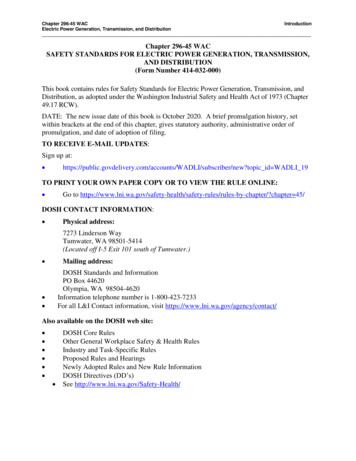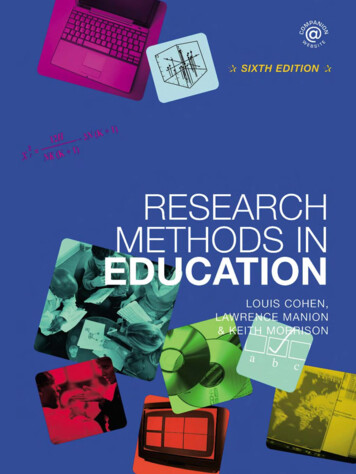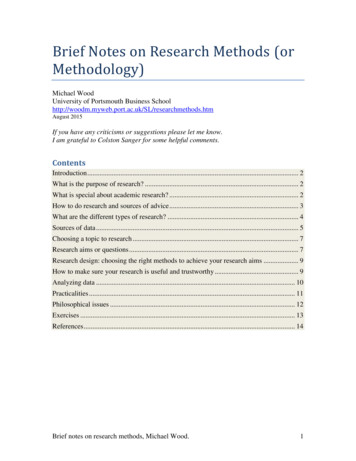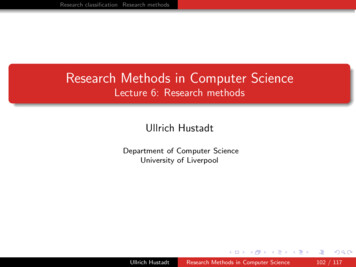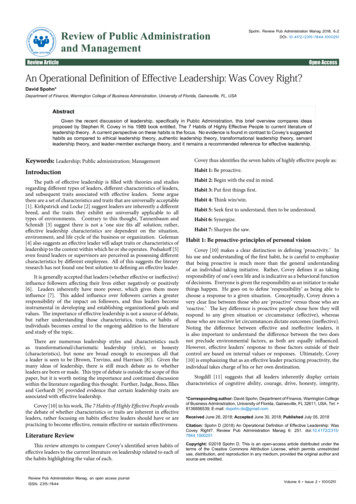
Transcription
Research Theory and MethodsLucille Parkinson McCarthyUniversity of Maryland Baltimore CountyBarbara E. WalvoordLoyola College in MarylandIn this chapter we (the research team) present the theoretical frameworkand research methods of this naturalistic study of students' writing infour classrooms. We begin by describing ourselves and our studentinformants. We then discuss our inquiry paradigm and research assumptions, our assumptions about classrooms, and our methods ofdata collection and analysis. Finally, we explain our ways of workingas a team and our ways of assuring the trustworthiness of our findings.THE RESEARCHERS AND THE STUDENTSAll four teachers on our team whose classrooms we studied:had participated in at least one writing-across-the-curriculumworkshop of at least 30 contact hours before the study of theirclassrooms beganhad subsequently presented or published on writing across thecurriculum (Gazzam [Anderson] and Walvoord 1986; Breihan 1986;Mallonee and Breihan 1985; Robison 1983)were experienced teachers who received excellent evaluations fromtheir students and colleaguesheld a doctorate and had published in their fieldswere in their 40shad been in their positions at least five yearswere tenuredhad been department heads (except Anderson)
Thinking and Writing in College18Walvoord asked these four teachers to collaborate because she judgedthem to be interested in their students, open to new ideas, andsufficiently self-confident to feel comfortable with her visits to theirclasses.The team and most of the students are white and from middle- orworking-class backgrounds (Table 2.1). Most students were betweenthe ages of 18 and 22 and were enrolled full-time in undergraduateday classes. Within that sector of American higher education, however,Table 2.1Characteristics of the Classes in the StudyShermanBreihanRobisonAnderson"Collegeof NotreDameTowson State U.InstitutionLoyola CollegeTypeCatholic liberalCatholicarts with strongliberalbusinessartsBaltimore CityLocationEnrollment"3876Mean verbal/CompositeSAT, enteringfreshmen516/1064CourseBusiness 330History 101ModernProductionCivilizationManagementYear of nrollment'4427Mean verbalSAT, course460542takers5 21'0561'0Female7%4%Minority2%0ESL7%0Age 24 Public comprehensive691BaltimoreSuburb11,086444/918Psych 165HumanSexuality437/911Biology 381BiologicalLiterature1986Fr./Soph."1983, 1986Jr./Sr.3013448100 / 23%17%10%n.a.54%15%8%0Anderson's 1983 and 1986 classes are the same number of people; the same percentage of female,minority, and ESL students, and those students covered the same age range.aFull time equivalent, total undergraduate and graduate school' Enrollment figures are for year of data collection.'' Course was planned for freshmen-sophomores, but due to unusual circumstances, primarily juniorsand seniors enrolled.
Research Theory and Methods19our discipline-based teachers and our students represent a range: Theteachers are two men and two women who teach in three differenttypes of institutions: a large, comprehensive state university; a small,Catholic women's liberal arts college; and a middle-sized, Catholiccoeducational college with a large business program. Both teachersand students represent the four major undergraduate discipline areas:business, humanities, social science, and natural science. The classesunder study ranged from freshman to senior and included requiredCORE, elective, and majors courses.OUR INQUIRY PARADIGM AND RESEARCH ASSUMPTIONSOur questions, as we began the study, were broad ones about students'thinking and writing. They were the general questions that Geertzsays are traditionally asked by ethnographers facing new researchscenes: "What's going on here?" and "What the devil do these peoplethink they're up to?" (1976, 224). We chose the naturalistic inquiryparadigm to ask those questions because it is based on the followingassumptions regarding:1. The nature of reality: Realities are multiple and are constructedby people as they interact within particular social settings.2. The relationship of knower to known: The inquirer and the "object"of inquiry interact to influence each other. In fact, naturalisticresearchers often negotiate research outcome; with the peoplewhose realities they seek to reconstruct; that is, with the peoplefrom whom the data have been drawn. Research is thus nevervalue-free. .3. The possibilities of generalization: The aim of a naturalistic inquiryis not to develop universal, context-free generalizations, but ratherto develop "working hypotheses" that describe the complexitiesof particular cases or contexts.4. Research methods and design: Naturalistic researchers use bothqualitative and quantitative methods in order to help them dealwith the multiple realities in a setting. Their research designstherefore emerge as they identify salient features in that settingfeatures identified for further study. Naturalistic researchers understand themselves as the instruments of inquiry, and acknowledge that tacit as well as explicit knowledge is part of the researchprocess. '
20Thinking and Writing in CollegeWe assume, then, that research questions, methods, and findingsare socially constructed by particular researchers in particular settingsfor particular ends (Harste, Woodward and Burke 1984). We recognizethat our own research practices were shaped by our discipline-basedperspectives, by our perspectives as teachers, and by our desire toconstruct findings that would help the teachers of the four classroomswe studied improve their teaching. Our perspectives shaped, forexample, our decision to focus on students' difficulties in meetingteachers' expectations and on those aspects of the classroom contextwriting strategies and teaching methods-thatwere, we felt, mostamenable to the teachers' influence.Because we are aware that our research findings were shaped byour perspectives, we "reflexively" explain wherever possible our ownas well as our informants' knowledge-construction processes, ourresearch assumptions, our decisions about data collection and analysis,and the collaborative procedures through which we arrived at ourfindings (Latour and Woolgar 1979, 273-286).Because knowledge in this collaborative study was constructed bymultiple researchers with varying perspectives and varying relationships to the classrooms under study, we have been careful to definethese perspectives and to have all team members tell at least parts oftheir stories in their own voices. (The relationship among the individualvoices and the "we" voice in each coauthored chapter differs somewhatand was worked out separately by each pair.) This type of coauthored,multivoice, reflexive discourse has been called "polyphonic," and webelieve it best reflects the intersubjective, "constructive negotiation"involved in producing our research findings (Clifford 1983, 133-140).Thus, we have worked to adequately represent the multiple andevolving realities of our students and ourselves as we constructed ourvarious types of knowledge and texts.OUR ASSUMPTIONS ABOUT CLASSROOMSRecently, several scholars have attempted to describe the dominantschools of thought currently represented in composition studies. Theyhave discussed those schools in terms of their theories of writing, theirapproaches to research and pedagogy, and their social and politicalimplications (Berlin 1988; Faigley 1986; Nystrand 1990). Of the threemajor perspectives identified by Faigley-the expressive, the cognitive,and the social-our study clearly belongs in the latter category.Our understanding of students learning to write in academic settings
Research T h e o y and Methods21is underlain by theoretical assumptions concerning language use fromsociolinguistics (Gumperz 1971; Heath 1982; Hymes 1972a, 197210,1974), literary studies (Fish 1980; Pratt 1977), and philosophy (Rorty1982). A central assumption is that language processes must beunderstood in terms of the contexts in which they occur. In this view,writing, like speaking, is a social activity that takes place within speechcommunities and accomplishes meaningful social functions. In theircharacteristic "ways of speaking," community members share acceptedintellectual, linguistic, and social conventions which have developedover time and govern spoken and written interaction. Moreover,"communicatively competent" speakers in every community recognizeand successfully employ these ways of speaking largely withoutconscious attention (Hymes 1972a, xxiv-xxxvi; 1974, 51). Newcomersto a community learn the rules for appropriate speaking and writinggradually as they interact orally and in writing with competent members, and as they read and write texts deemed acceptable there. Wechose to see the classroom within this theoretical framework.In our view, when students enter a classroom, they are entering adiscourse community in which they must master the ways of thinkingand writing considered appropriate in that setting and by their teacher.We also understand their writing to be at the heart of their initiationinto new academic communities: it is both the means of disciplinebased socialization and the eventual mark of competence-the mark,that is, of membership in the community.As students write, they must integrate the new ways of thinkingand writing they are being asked to learn with the already-familiardiscourses that they bring with them from other communities. AsBruffee puts it, students "belong to many overlapping, mutuallyinclusive knowledge communities" (1987, 715). We believe that students may experience conflict among these ways of knowing, as oldand new discourses vie for their attention.Further, we understand reading, as we do writing, to be an interactivelanguage process that is at once individual and social. Readers, Iikewriters, construct meanings as they interact with written texts andwith other aspects of the social situation, such as their explicit purposesfor reading and the implicit values of the community (Pratt 1977;Rosenblatt 1978).Teachers, then, construct meanings as they read students' writing,and the success of a student's work reflects such aspects of the readingcontext as the teacher's current relationship with the class and thatstudent, the meanings and values (tacit and explicit) that the teacherassigns to the text, and the expectations (tacit and explicit) that the
22Thinking and Writing in Collegeteacher has for text content and structures. The success of students'work also depends on the teacher's expectations about the role thestudent writer should assume in the piece. Sullivan (1987), studyingthe "social interaction" between placement test evaluators and thestudent writers they infer from those essay tests, observes that "readersconstruct writers as well as texts" (11).Similarly, we view the student's writing development as a socialprocess best understood not only as occurring within an individualstudent, but also in response to particular situations. We are typical ofnaturalistic researchers in that often we are "less concerned with whatpeople actually are capable of doing at some developmental stage thanwith how groups specify appropriate behavior for various developmental stages" (LeCompte and Goetz 1982).These theoretical assumptions about the classroom have shaped ourchoices of research questions and methods, and thus, ultimately, theyhave shaped the construction of our findings and interpretations.DATA COLLECTION METHODSBecause we understand writing to be a complex sociocognitive process,we worked to view it through multiple windows. We assumed thatdata collected from a variety of sources would give us such multiplewindows and would help us construct as full a view as possible ofstudents completing their assignments in each of the four classrooms.Our aim was to investigate the entire classroom community, but withinthat community to focus on a single "salient eventf'-the writingassignment-theoutcome of which was crucial to the life of thecommunity (Spindler 1982, 137). Because our initial research questionswere broad, we collected a wide range of data about students' thinkingand writing and about the classroom context. This, we reasoned, wouldbe the basis for the subsequent narrowing of our research questionsand foci at later stages of the project.CHOOSING THE "FOCUS" ASSIGNMENTSIn the history and business classes, we tracked students' progressacross the entire semester, and thus we asked them for process dataon all their written assignments. In the biology and psychology classes,we asked students to collect data about their writing processes only
Research Theory and Methods23for a single assignment that their teachers judged central to achievingtheir course goals. In all four classes we collected data about theclassroom setting for the entire semester.EXPLAINING DATA PRODUCTION TO STUDENTSWe wanted to separate students' data production from their concernsabout their grades and to minimize the possibility that they might tryto produce data that they thought would please the teacher. Thus,Walvoord, rather than the classroom teacher, initially explained theresearch project to students and collected all data from them, exceptdrafts or final papers normally given to the teacher. Both Walvoordand the teacher assured students that the teacher would not see anystudent data until their final grades for the semester had been turnedin.Before the teacher explained to students the writing assignment thatthe research would focus on, Walvoord visited the class and did thefollowing:1. Described the research in very general terms and told students,"We are interested in everything you do and think about as youwork on the assignment."2. Distributed a list of all the kinds of data we wanted from them,explaining each type and answering their questions.3. Conducted a training session for those students who would bemaking think-aloud tapes.4. Walvoord then recruited two student volunteers who were enrolled in class. These students, for a stipend of 25.00, agreedto act as observers for each class session of the semester. Afterclass she instructed these observers and gave them sheets to fillout about all subsequent class sessions during the semester. Thesestudents also submitted the same data as their peers.5. Walvoord reemphasized to students that they should record intheir data what they actually thought and did, and that theyshould work in their customary ways and places.When Walvoord had finished her initial presentation to each class,the teacher explained that he or she supported the research and hadslightly revised the course syllabus to allow for the extra time studentswould spend collecting data.The revision varied from course to course. In the psychology and
24Thinking and Writing in Collegebusiness classes, a short, end-of-semester paper had been omitted tocompensate for time spent generating data. In the history class, nopapers were omitted, but students received extra points for handingin data. In the biology class, no compensation was made or announced;students were simply asked for their help. (Because that biology classwas identified as "writing intensive," the students expected to focuson their writing.)After her initial visit, Walvoord attended each class several times toobserve and to collect data. When she was not present, the teacheranswered students' questions about data collection. At the next sessionafter Walvoord's explanation, some students in each class expressedfears or reluctance about the data collection, especially about the thinkaloud taping. In each case, the teacher reiterated his or her supportfor the project and urged students to give it a fair trial. In the businessclass three students came privately to the teacher or to Walvoord afterthey had tried think-aloud taping and asked to be excused becausethey found it too disruptive. We granted their requests.In the description of our data sources which follows, we havedivided the data into two categories: data generated by students anddata generated by teachers.DATA GENERATED BY STUDENTSData generated by students is summarized in Table 2.2. In the business,history, and psychology classes, 100 percent of students submittedsome usable data. In the biology class 85 percent of the students didso.Students' LogsFrom all students, we requested a writing log in which they wouldrecord their activities and their thinking as they worked on theassignment. Activities included planning, gathering information, reading, note making, consulting with other people, drafting, and revising.Sherman's business students and Breihan's history students were askedto keep logs for the entire semester because we were tracking studentdevelopment in their classes. Robison's psychology students and Anderson's biology students were asked to keep logs only during theweeks in which they worked on the focus assignments.When Walvoord initially explained the logs, she asked students todate each entry and address the following questions:
Research Theory and MethodsTable 2.225Data Generated by Final paper with teacher commentInterviews by WalvoordPeer response/peer interviewsTaped interaction with others outsideof classParagraph describing self as writerThink-aloud tapesStudents' class evaluations* Percentage of stratified sample asked to tape (about half the class: business: 24 students; history:14 students) Students who submitted usable data: 44 (business), 27 (history), 30 (psychology), 11 (biology)NWhat did you do today on your project?What difficulties did you face?How did you try to overcome the difficulties?How do you feel about your work at this point?The logs helped establish a chronological scaffolding within whichother data, more detailed and specific about certain parts of the writingprocess, could be placed. We recognized, with Tomlinson (1984), thatretrospective accounts in the logs are limited by students' memories,their interpretive strategies for telling the "story" of their writing, andtheir consciousness that these writing logs are for the researcher. Thus,as Tomlinson suggests, we included specific questions designed to keepstudents close to recall of the assignment they were reporting, and weurged them to write in their logs immediately after each work session.Changes in handwriting, pen color, and students' responses to thosequestions gave us some indication that many of them had compliedwith our request. Tomlinson notes that retrospective accounts providevaluable information about students' conceptions of writing. We foundthis to be true. The students' retrospective descriptions and reflectionsabout each work session as recorded in their logs usually containedinformation about their processes at a higher level of abstraction thandid their think-aloud tapes.'
26Thinking and Writing in CollegeStudents' Pre-Draft Writing and Draftsand Teachers' CommentsFrom each student, for each focus assignment, we requested all finalpapers (including any teacher comments) as well as all pre-draft writing(including freewriting, reading and lecture notes, charts, and outlines)and drafts. We asked students to number pages, to date each piece ofwriting, to label their drafts ("draft 1," "draft 2'7, and, in their logsand think-aloud tapes, to identify the pieces of writing they wereworking on. If they revised a manuscript in more than one sitting, weasked them to use different colored pens or pencils for each separatesession. Most students complied sufficiently to allow the researchersto agree on the chronology of their writing activities as they wrote apaper and to match think-aloud tapes to written drafts.Walvoord's Interviews with StudentsBetween three months and four years after the course was finished,Walvoord conducted open-ended or discourse-based interviews witha few students in the history, psychology, and business classes (DohenyFarina 1986; Odell, Goswami, and Herrington 1983; Spradley 1979).She interviewed students whose data had been, or promised to be,particularly useful. Information from these interviews added to, refined,and cross-checked information from our other data sources.Peer Interviews and Peer Responses to DraftsIn each class, for each student, we arranged at least one tape-recorded,student-to-student interview or one peer response to a draft, eitherduring the writing of the focus assignment or on the day it was handedin. Biologist Anderson followed her usual practice of having herstudents interview each other in class about the experimental andcomposing processes they were using as they worked on their papers.She gave students a question sheet she had designed to guide theseinterviews. Psychologist Robison followed her usual practice of usinga checklist to structure in-class peer response to the drafts. ForSherman's business and Breihan's history classes, where neither peerinterviews nor peer response to drafts were normally used, we arrangedfor each student to be interviewed about one of their assignments, ontape, by a student from one of Walvoord's freshman compositionclasses.
Research Theory and Methods27In training her freshmen to interview the business and historystudents, Walvoord explained that the purposes of the interviews wereto help with this project and to get information about the kinds ofwriting they, the freshmen, might themselves someday be assigned.She gave her students a series of interview questions to which theywere to add at least three questions of their own. Then she modeledan interview for them, had them interview each other about one oftheir freshman composition essays, and arranged times for them tomeet with Sherman's and Breihan's students.Although we were aware that the usefulness of interview dataproduced by unskilled interviewers would be limited, we did get frankresponses from the history and the business students and a valuablesample of student-to-student language. Further, comparisons amongstudents were possible because in three of the four classes, virtuallyevery student was asked on the same day, "What part of the assignmentwas most difficult for you?" (These difficulties, as we have said,increasingly became our focus as the study progressed.) Informationfrom this data source, then, served to augment and cross-checkinformation from our other data sources.Students' Taped, Outside-Class InteractionsIn their logs or think-aloud tapes, many students described out-ofclass interactions with classmates, parents, or others. A few of themactually recorded these interactions. In Breihan's history class, forexample, five students made tapes of their student-organized studysessions in the dorm. In Robison's psychology class, three studentsgave us tapes of their conversations with peer helpers (in one case aroommate, in two cases a classmate). One of Anderson's biologystudents made a tape of his friend, a graduate student in biology,responding to his draft. These tapes provided particularly usefulinformation about how students gave and sought help from othersand how that help served them.Students Describing Themselves as WritersIn Robison's class, where all students were asked to make think-aloudtapes, part of their training involved their thinking aloud as they wrotea paragraph in which we asked them to tell us "something aboutyourself as a writer." These paragraphs were then used as data.
Thinking and Writing in CollegeThink-Aloud TapesWe asked all the students in two classes (psychology and biology) anda stratified sample of about half the students in two of the largerclasses (history and business) to record think-aloud tapes wheneverthey were "working on" the assignment. We wanted to get thinkaloud information about their entire writing process, extending as itoften did over days or even weeks.At the beginning of the semester, in each of the four classrooms,Walvoord trained students who would be making think-aloud tapes.Her instructions to the students were modeled on those suggested bySwarts, Flower, and Hayes (1984, 54). She asked them to "say aloudwhatever you are thinking, no matter how trivial it might seem toyou, whenever you are working on" a focus assignment. That is, theywere to think aloud during their entire writing process, from theirearliest exploration and planning, during reading and note taking,through drafting, revising, and editing. Walvoord asked them to tapewhenever and wherever they could, and gave those students whoneeded them tape recorders to take with them. She told them to workas they usually did and to forget the tape recorder as much as possible.Next, Walvoord demonstrated thinking aloud as she composed aletter at the blackboard. Finally, she asked students to practice thinkingaloud as they composed, at their desks, a short piece about an aspectof the course or a paragraph about "yourself as writer."In order to minimize the disruptiveness of the thinking-aloud process,our instructions to the students about taping were purposely general,and did not specify particular aspects of their writing that we wantedthem to talk about. We were aware of Ericsson and Simon's (1980,1984) conclusion that though thinking aloud may slow the thoughtprocess, it does not change its nature or sequence unless subjects areasked to attend to aspects they would not usually attend to.Although we were aware of questions regarding the extent to whichwriters' subjective testimony can be trusted (Cooper and Holzman1983, 1985; Ericsson and Simon 1980; Flower and Hayes 1985; Hayesand Flower 1983; Nisbett and Wilson 1977), we reasoned that thesetapes would afford us information about students' thinking and writingprocesses that we could get in no other way. Berkenkotter (1983), whoalso studied think-aloud tapes made by her writer-informant in naturalistic settings when she was not present, notes that "the value ofthinking-aloud protocols is that they allow the researcher to eavesdropat the workplace of the writer, catching the flow of thought that wouldremain otherwise unarticulated" (167). Throughout the project we
Research Theory and Methods29understood that our request for tapes was, in essence, like asking ourstudents to let us "eavesdrop" at their workplaces. More often thannot, we were amazed at their generosity and hospitality.Characteristics of the Think-Aloud TapesThe information we got from the students' think-aloud tapes was richand varied. Because students recorded them in various settings overextended periods of time with no researcher present, the tapes containedmore types of information than do the composing-aloud protocolsmade in laboratory settings in a limited time period, often with aresearcher present. These latter protocols generally record writers'concurrent thoughts-that is, thoughts verbalized while the writer iscomposing (Berkenkotter 1983; Flower and Hayes 1980, 1981a, 1981b;Perl 1979). Similarly, our think-aloud tapes contained students' concurrent thoughts as they composed their drafts, but in addition, thetapes provided us with several other sorts of information.The first type of information was students' retrospective commentsabout what they had just done on the assignment and how they feltabout it, what had been particularly hard for them and what theymight have done differently. They also talked about their plans forfurther work on the assignment. At times students seemed to use thissort of monitoring of their writing processes to help them proceed.At other times students appeared to be speaking directly to theresearchers, informing us about their past or future processes, andhow they felt about them. This latter situation often occurred whenstudents had worked in settings where they could not think aloudfor example, in the library while gathering information, or in thecollege pool planning a paper while swimming laps. Such retrospectivedescriptions and analyses of their writing processes were also necessarywhen students found thinking aloud too distracting and had turnedthe recorder off.Students were, however, able to turn on the tape recorders in manysettings, giving us a third type of information: information about thephysical conditions in which they worked. They turned on their taperecorders as they conducted scientific experiments, as they planned apaper while driving to school or when at work, and as they composedat home or in the dorm. Furthermore, these tapes reveal much aboutthe affective conditions under which students work. They were, forexample, distracted by personal problems, interrupted frequently bythe phone or by roommates, worried about exams in other courses,or anxious about their writing ability. In addition they wrote whenthey were hungry, fascinated, tired, bored, or enthusiastic.
30Thinking and Writing in CollegeThe tapes, although generally informative and useful, were notwithout their deficiencies. This is to be expected, since our studentswere trained only briefly and worked with no researcher present. Fromsome students, we got only glimpses of their processes when wewished we could have had a steady gaze; for example, some werethinking aloud on tape when, just as things were getting interesting,they turned the recorder off. We then got from many of those studentsa summary of what we had missed, which they recorded later.Moreover, there were some students who never produced concurrentthoughts or useful introspection, but rather said aloud on tape onlythe words they were writing on the page. Nevertheless, these tapesstill gave us some sense of the pace and tone of the composing session,and we used whatever they contained, along with our other data, aswe worked to reconstruct our students' thinking and writing processes.Classes differed in the number of students who complied with ourrequest to submit think-aloud tapes. In Anderson's biology, Robison'spsychology, and Breihan's history class, 67 percent to 91 percent ofthose who were asked submi
Research methods and design: Naturalistic researchers use both qualitative and quantitative methods in order to help them deal with the multiple realities in a setting. Their research designs therefore em

